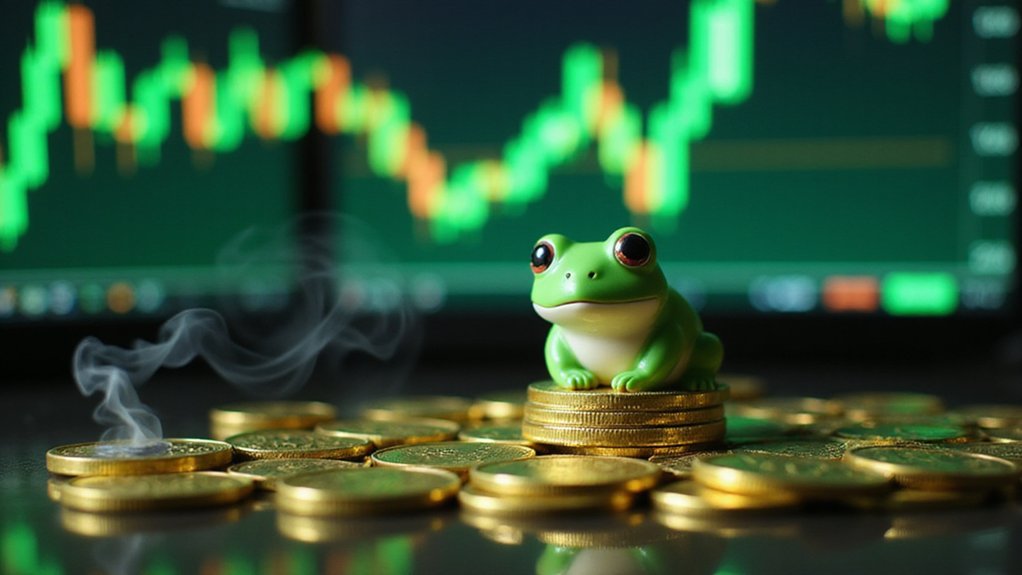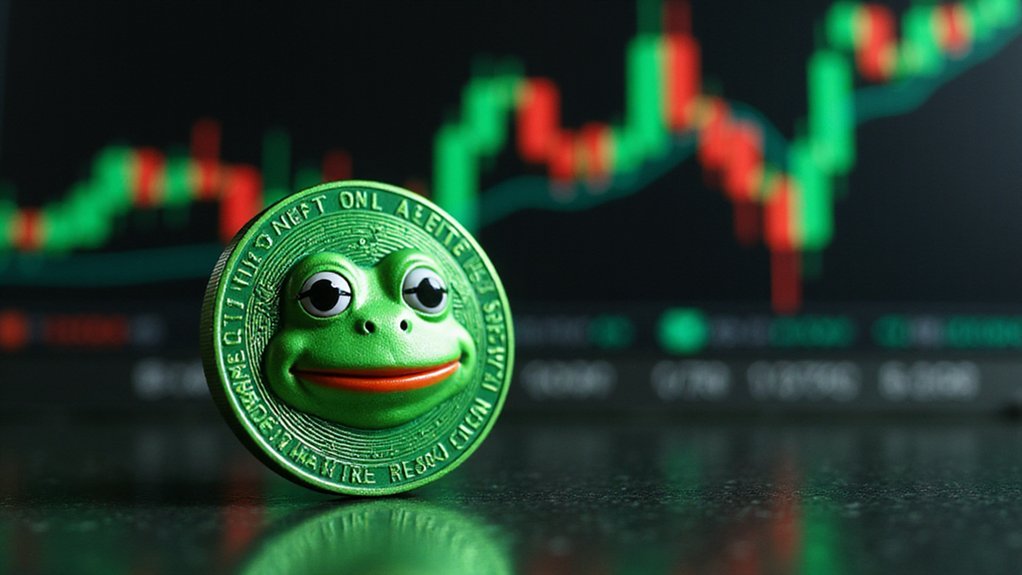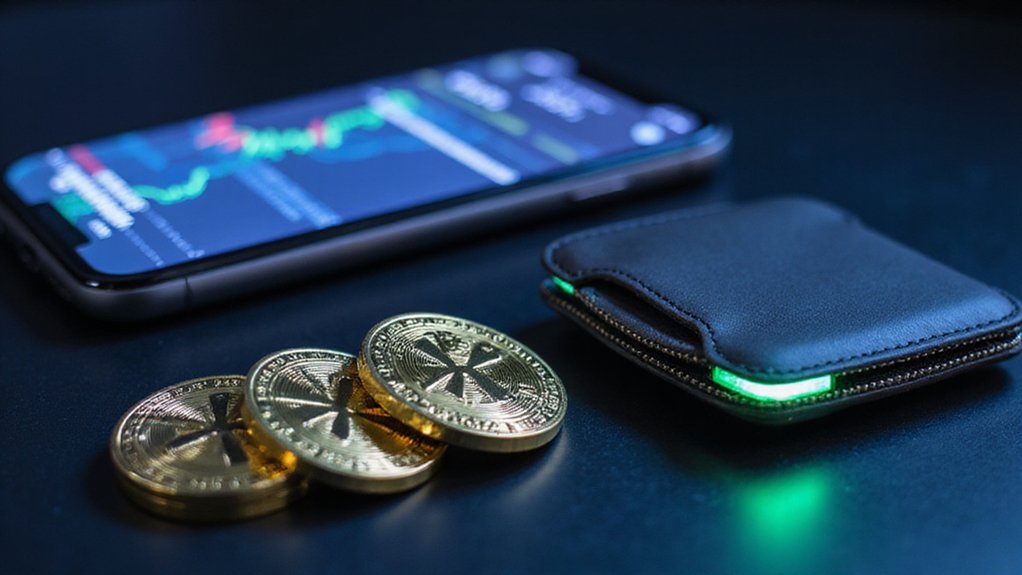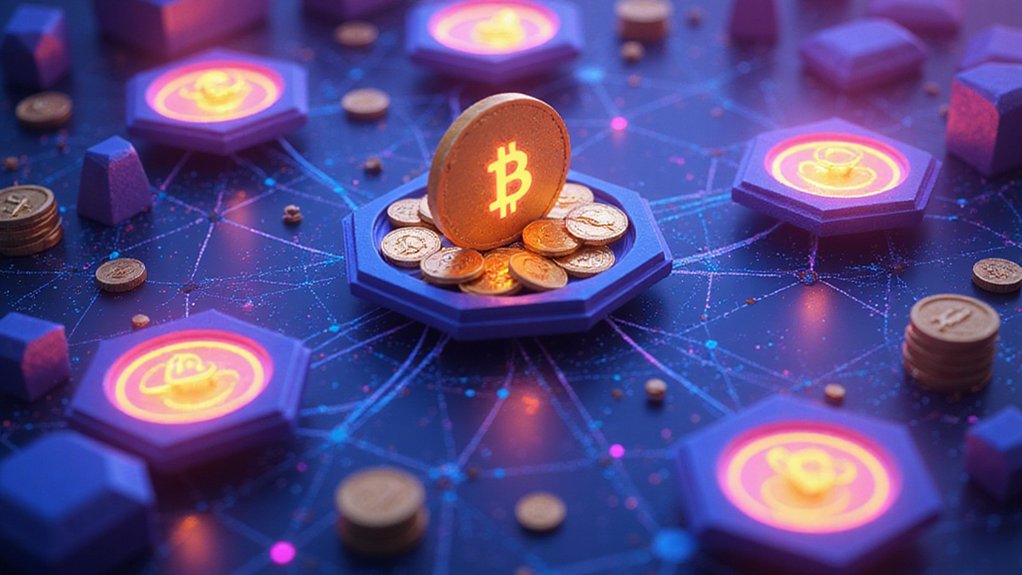Pepe Coin (PEPE) is an Ethereum-based meme token launched in April 2023, catapulting to a remarkable $5 billion market cap in mere weeks. This deflationary cryptocurrency features no transaction taxes or developer allocations, instead embracing community-driven distribution and governance. Despite lacking explicit utility beyond its amphibian-inspired charm, PEPE maintains investor interest through strategic token burns and exchange listings. The coin’s meteoric rise demonstrates how internet culture can transmute digital nostalgia into tangible—if wildly volatile—financial assets.

What do you get when internet meme culture collides head-on with cryptocurrency speculation?
The answer, it seems, is Pepe Coin (PEPE)—an Ethereum-based digital token that catapulted from obscurity to a staggering $5 billion market capitalization following its April 2023 launch.
Based on the ubiquitous internet meme Pepe the Frog, this cryptocurrency exemplifies the peculiar intersection of absurdist humor and financial opportunity that characterizes the contemporary digital asset landscape.
The meme-to-money pipeline where absurdist frogs generate real-world fortunes in crypto’s carnival economy.
Unlike many of its contemporaries in the meme coin ecosystem, PEPE distinguishes itself through its deflationary tokenomic structure and no-tax policy.
While competitor Pepe 2.0 imposes transaction fees, PEPE opted for a frictionless trading experience—a decision that likely contributed to its explosive adoption curve.
The token’s deflationary mechanism, which burns a portion of coins with each transaction, theoretically enhances long-term scarcity (though one might reasonably question the intrinsic value being made scarce).
The project’s community-centric approach extends to its token distribution model, which conspicuously lacks developer allocations—an innovative departure from the pre-mines that have become de rigueur in token launches.
This democratized ownership structure aligns with the project’s emphasis on decentralized governance, though not without complications.
Like most meme coins, PEPE relies heavily on social media hype and community engagement rather than providing any specific utility.
August 2023 brought turbulence when tokens mysteriously migrated from project wallets to exchanges, triggering market anxiety and highlighting the inherent volatility of meme-based assets.
Subsequent recovery efforts included accelerated token burns and expanded advisory oversight—standard crisis management protocol in the wild west of cryptocurrency markets.
Looking forward, PEPE’s roadmap emphasizes exchange listings, community partnerships, and continued deflationary burns.
Yet prospective investors should note the absence of explicit utility beyond meme-based entertainment value and speculative potential.
Pepe currently has a circulating supply of 420,689,899,653,543.56 PEPE tokens, bringing it remarkably close to its maximum supply cap.
Despite the lack of utility, Pepe Coin achieved the remarkable feat of reaching the top 100 by market cap in just two weeks after its launch.
The ERC-20 token represents a fascinating case study in how social capital and internet culture can rapidly transmute into financial value, however ephemeral that value might ultimately prove to be.¹
¹And ephemeral it often is, as the graveyard of defunct meme coins attests.
Frequently Asked Questions
How Does Pepe Coin Differ From Other Meme Cryptocurrencies?
Pepe Coin distinguishes itself through its Ethereum-based security framework and deflationary mechanism, which burns tokens with transactions to create scarcity.
Unlike competitors such as Pepe 2.0 (which imposes transaction taxes), Pepe maintains a no-tax policy—enhancing accessibility while still reducing supply.
Its rapid achievement of $5 billion market capitalization demonstrates remarkable traction, while its community-centric approach and strategic roadmap objectives provide a foundation beyond mere meme status.
What Are the Main Risks of Investing in Pepe Coin?
Investing in Pepe Coin entails substantial risks typical of the meme coin landscape.
Primary concerns include extreme price volatility driven by social media sentiment rather than fundamentals, complete absence of intrinsic utility or technological innovation, and fierce competition in an increasingly saturated meme coin market.
The investment demands exceptional risk tolerance, as the token remains vulnerable to rapid value deterioration, regulatory scrutiny, and the ephemeral nature of internet culture that underpins its very existence.
Can Pepe Coin Be Staked for Passive Income?
No, Pepe Coin cannot be traditionally staked for passive income.
The token lacks built-in staking functionality, with no official staking program in its roadmap or whitepaper.
While holders may benefit from redistribution mechanisms that share transaction fees among existing holders, this differs fundamentally from proper staking protocols.
The passive income potential relies primarily on the token’s deflationary nature and redistribution system—both of which depend heavily on transaction volume rather than formalized yield-generating mechanisms¹.
¹This redistribution feature has reportedly been under discussion for possible discontinuation.
Which Major Exchanges Currently List Pepe Coin?
Pepe Coin has secured listings on several major cryptocurrency exchanges, enhancing its accessibility and liquidity profile.
Notable platforms include Binance, OKX, Bybit, KuCoin, and Kraken—exchanges that typically maintain stringent listing requirements.
Additionally, the token has penetrated mid-tier platforms like Gate.io and MEXC.
This widespread exchange presence has contributed substantially to PEPE’s trading volume, which remains robust despite the token’s inherently speculative nature as a meme coin.
What Is the Long-Term Roadmap for Pepe Coin?
Pepe Coin’s long-term roadmap, structured in three phases, aims to transcend typical memecoin trajectories through sustainable development rather than mere hype-chasing.
The PEPE Ascension initiative prioritizes community expansion, ecosystem integration via wallet partnerships, and enhanced tokenomics featuring staking mechanisms.
While price predictions range from bearish ($0.0000059) to bullish ($0.000045) by 2029, the absence of exhaustively detailed plans leaves investors balancing between speculative optimism and the graveyard of abandoned meme projects.









